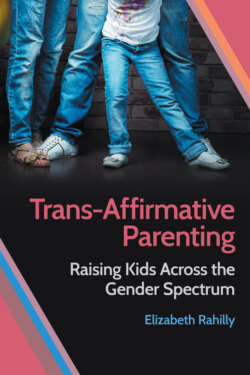Trans-Affirmative Parenting

Реклама. ООО «ЛитРес», ИНН: 7719571260.
Оглавление
Elizabeth Rahilly. Trans-Affirmative Parenting
CONTENTS
Introduction
Trans-Affirmative Parenting
Terminology
The Parents
Storytelling against Time
The Outsider With(out)
Historical and Cultural Contexts
Parenting, Race, and Class
Feminist Precursors
The Transgender Child
LGBT/Q Rights
Overview of the Book
1 “She’s Just Who She Is”
“So That Maybe Muddied the Waters”: Feminist Foundations
Toys, Clothes, Preferences: Early Observations
The “Tomboy” Problem
“He Said This and It Was So Freaking Profound”: Verbal Declarations
Coming to “Transgender”
Conclusion
2 “Our World Has Been Rocked”
Gender and Sexuality at a Crossroads
Early “Gay” Interpretations
Notorious Statistics
The (Cisgender) Gay Adult
Open to Change
Conclusion
3 “Picking the ‘Other Box’ ”
Binary and Nonbinary Possibilities
Parents’ (Non)Binary Politics
Follow-Up Vignettes: Movement across the Spectrum
“Gender-Nonconforming to Transgender”
ALLY AND ELIAS
BECCA AND NATHANIEL
“Gender-Nonconforming to Cisgender(ish)”
LAURIE
BETH AND BARRY
Conclusion
4 “A Regular, Normal Childhood”
Privacy and Power
“Sadie Does Not Hate Her Body, She Just Desires the Body of a Female”: Body Talk
“Birth Defects” and Body Logics
Alternative Discourses
Conclusion
Conclusion
Gender and Sexuality at a Crossroads
Male Femininity and the Gender (Non)Binary
Body Logics
Trans-Affirmative Parenting Here and Now
ACKNOWLEDGMENTS
APPENDIX I
APPENDIX II
The Parents
The Children of the Parents
Methods
Ethics and Politics
NOTES. INTRODUCTION
CHAPTER 1. “SHE’S JUST WHO SHE IS”
CHAPTER 2. “OUR WORLD HAS BEEN ROCKED”
CHAPTER 3. “PICKING THE ‘OTHER BOX’ ”
CHAPTER 4. “A REGULAR, NORMAL CHILDHOOD”
CONCLUSION
APPENDIX II
REFERENCES
INDEX
ABOUT THE AUTHOR
Отрывок из книги
TRANS-AFFIRMATIVE PARENTING
Raising Kids Across the Gender Spectrum
.....
As historians have shown, our very conceptions of “childhood,” and what “the child” is, are culturally and historically contingent, and change across time and place.31 For example, prior to the Industrial Revolution in the United States, many children worked as valuable laborers and producers in their own right, first of the farmland and the household, and later of the industrializing economy. This changed over the course of the nineteenth and twentieth centuries with the help of child labor laws and expanding school systems. The rise of the gendered division of household labor contributed as well, especially among the white middle class. New cultural ideologies, in tandem, marked the child as “precious,” as someone to be nurtured and protected at home under their mother’s care while fathers earned money outside the home.32 Of course, these cultural ideals relied on real structural inequalities, in which the low-wage labor of working-class families, immigrant families, and/or families and children of color permitted such idealized arrangements among middle-class nuclear households.33 But this history demonstrates that “childhood” and “the child” are intimately tied to cultural, historical, and economic contexts.
Today, children are considered an all-important labor unto themselves, an individualized project to be “sculpted, stimulated, instructed, and groomed” by their parents.34 Parents do this through a smorgasbord of resource- and time-intensive activities, from soccer practice and dance rehearsal to mommy dates and daddy dates to college prep and private tutoring, all coupled with the help of biomedicine, psychology, and psychiatry. As journalist Jennifer Senior put it, “Kids … went from being our staffs to our bosses.”35 This intensive mode of child-rearing is not only reinforced by consumer capitalism, with a marketplace of goods, services, and experts that drive it, but is morally imposed and surveilled by a collective social other, in which “good” and “bad,” “right” and “wrong” parenting is constantly assessed and scrutinized—in popular discourse and media, across parenting blogs and advice pages, and within parenting groups.36 Amid this wider culture of intensive, moralized child-rearing—and in the wake of both a feminist parenting legacy and the LGBTQ rights movement, as I chart later in the chapter—the gender-nonconforming child presents a particularly apt project for specialized attention, scrutiny, and care. Indeed, as I learned, the care of a gender-nonconforming child can entail a host of services and expenses, including mental health therapists, medical doctors, and related fees; annual conferences and summer camps; consultations with various advocacy organizations, as well as the time and the means to look into all these options in the first place.
.....